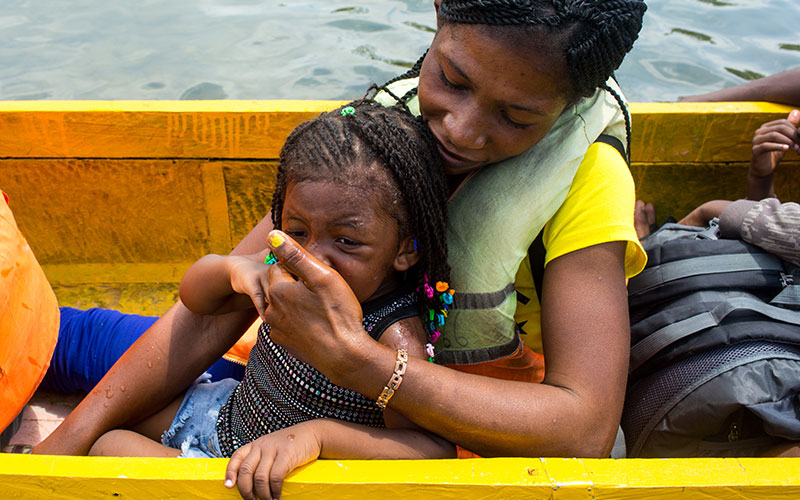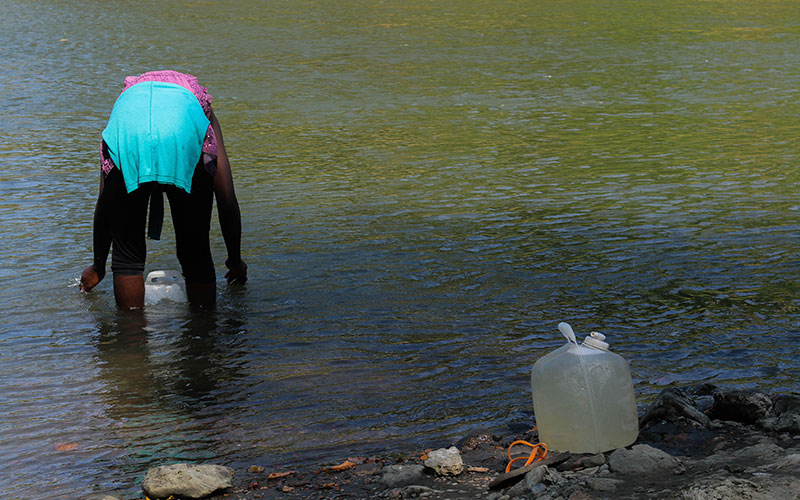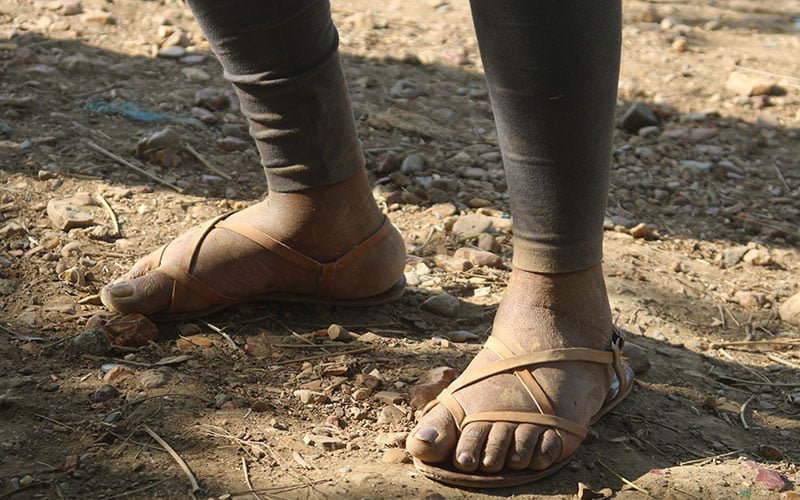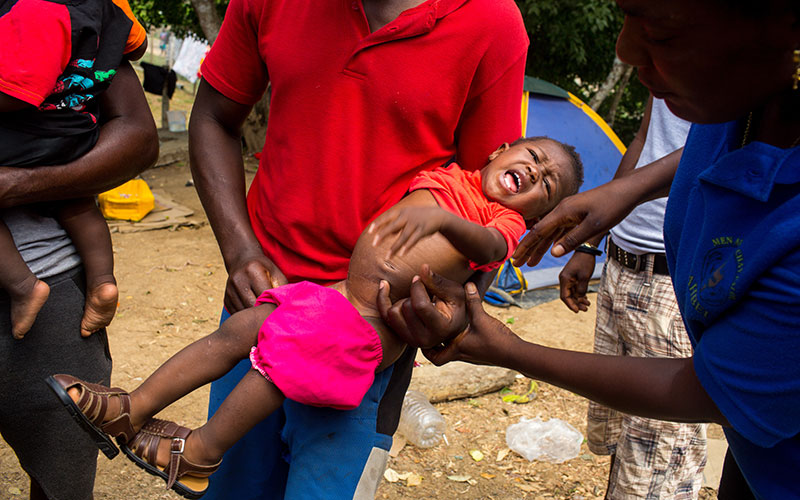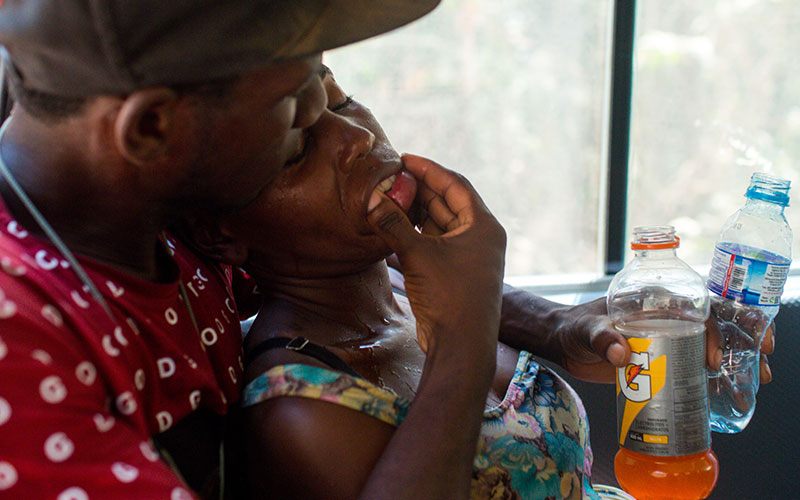- Slug: BC-CNS-Panama Water,1960
- Audio clip of Djom Silo Claire.
- 9 photos, graphic available (thumbnails, captions below)
By Natalie Walters
Cronkite Borderlands Project
BAJO CHIQUITO, Panama – It’s 90 degrees on a March Saturday morning in Bajo Chiquito, a migrant camp and main stopover for many of the thousands of migrants who head north through Panama each year, on their way to the United States. About 100 women, men and children wait in long wooden boats to continue on their journey north. A mother dips her hand in the brown river water and gently scoops it up to her daughter’s mouth.
The child looks down the river toward a group of migrants bathing, brushing their teeth and relieving themselves in the same river. She takes a sip.
For the 800 migrants in Bajo Chiquito – a number that fluctuates weekly – the Tuquesa River provides their drinking water and bathwater – and serves as their toilet.
The responsibility to provide safe water in Panama’s migrant camps falls to the national Ministry of Health, but it has had to rely on the Red Cross and UNICEF for funding.
So far, those groups have provided one water filter in one camp – La Peñita – while Bajo Chiquito still relies on the contaminated river water. For the health ministry, the issue is complicated considering 70% of Panama’s Indigenous population still lacks access to clean water, according to the MDG Achievement Fund, a nongovernmental organization working to end poverty.
Safe drinking water is the greatest need for migrants coming into Panama through the treacherous Darién jungle along the border with Colombia, according to humanitarian organizations. Bajo Chiquito is the first place many of those migrants stop after emerging from the jungle – often dehydrated and emaciated from the journey.
“The top concern in the camps now is water and sanitation because that is directly related to many long-term health issues,” said Juan Villegas, international director of strategic initiatives for Global Brigades Inc., which seeks to improve the health of people in low-resource areas.
At the beginning of May, the Red Cross funded a small, emergency drinking water system at the reception station in Bajo Chiquito. However, with about 2,500 migrants stuck in Panama as countries close borders to stop the spread of COVID-19, advocates said officials need a more permanent solution if Bajo Chiquito continues to serve as the main stopping point for migrants.
Diarrhea and skin rashes related to poor drinking water and sanitation are the most common ailments in the migrant camps in Panama, especially for the children, according to health workers who visit the camps.
According to the Centers for Disease Control and Prevention, about 88% of diarrhea-related deaths worldwide are due to unsafe water, as well as inadequate sanitation and hygiene. When people urinate and defecate in the same water used for drinking and food preparation, it can easily spread germs, according to the CDC.
Each year, more than 800,000 children worldwide die of diarrhea, according to the CDC. Last year, nearly 4,000 children came through the Bajo Chiquito camp and used the river water.
“There’s a problem with the water because they need to go to the bathroom every day,” said Roderick Vega, a major for SENAFRONT, Panama’s border patrol, which oversees the camps where they detain migrants for background and medical checks before allowing them to proceed through Panama.
Pregnant women also rely on contaminated water in Panama. Last year, 400 pregnant migrants entered through the country through the Darién Gap, according to UNICEF. Mircagnard Janvier, who was four months pregnant, was one of the 100 migrants boarding the boats to head to the next camp on a Saturday in early March. She was left behind after becoming ill. Soon after the boats left, she lost consciousness.
Three days earlier, a doctor at the camp told Janvier that she had an infection from the river water she had been drinking. The doctor told her to buy bottled water and rest. But two days later, she was out of money and back to drinking from the river.
SENAFRONT took Janvier on a two-hour bumpy ride to the women and children’s clinic Centro Materno Infantil in the town of Metetí, where she received treatment for dehydration.
Bajo Chiquito is a crucial point in a migrant’s journey to the U.S. because it’s the first stop migrants reach after traveling by foot for one to two weeks through the Darién Gap, a jungle notorious for its flash floods, bugs, snakes, robbers, drug cartels and human traffickers. Organized groups often steal migrants’ passports and money in the jungle by pretending to be security officials who have the authority to look through belongings.
Migrants’ health is often suffering by the time they reach Bajo Chiquito, said Diane Edrington, a Mississippi-based nurse practitioner who takes several trips a year to treat migrants as part of the Panama Missions humanitarian group.
“Usually, they’re barefooted, and by the time they reach one of the camps, most of them can’t even walk because their feet are so swollen,” she said.
But far from a respite, the migrants encounter severely overcrowded conditions – often 800 migrants in a camp built for 100 – leaving the majority without shelter. They don’t have access to a bathroom, leading them to defecate in the river or on the riverbank, next to their single water source.
And in the wet months from April to January, the risk of using the river rises dramatically as migrants who can’t swim often drown while trying to bathe or drink. Panama’s average annual rainfall is about 40 inches, slightly above Seattle’s yearly average of 38 inches.
People drown on a near-weekly basis during the wet season, according to Sally Edwards, sustainable development and environmental health advisor for the Pan American Health Organization.
Djom Silo Claire left Cameroon because war cut off her education, food sources, and, ironically, her safe drinking water. She first flew into Ecuador because of its lax visa requirements before journeying through the Darién jungle to Bajo Chiquito, where she said many migrants had rashes, eczema and diarrhea from the water.
Once in Bajo Chiquito, she couldn’t afford the $25 boat ticket to the next camp because robbers took her phone and money in the jungle, she said. Instead, she walked six hours on foot without water in 90-degree heat to La Peñita, the next border patrol camp north.
“I wouldn’t advise anyone (to take the same journey),” she said. “No one. Because I’ve seen getting through (the jungle), it’s like hell. It’s very difficult, and for someone that is very fragile, that is fragile with their health condition and their body, it’s not really encouraging.”
La Peñita: the next stop
A two-hour boat ride away, La Peñita serves as an example of what safe water can do for a community. In August, Red Cross and UNICEF funded a $2,000 water filtration system that has changed the lives of both the locals and the migrants.
“The water is the principal problem in the area because it has lots of bacteria and causes constant stomach problems,” said SENAFRONT’s Vega. “But the filters here (in La Peñita) solved the problem because they don’t have many issues now.”
While no formal testing has been done to determine if the river water was causing the frequent diarrhea cases, there is little doubt, according to UNICEF protection and migration officer Margarita Sánchez, who works at the UNICEF health tent in La Peñita. She said that because migrants arriving in La Peñita have been drinking river water for weeks in both the jungle and Bajo Chiquito, it takes time for them to recover.
“Once they’re here, they feel better,” she said.
In addition to safe drinking water, there also are toilets. However, there are only nine portable toilets in the camp, which was hosting 800 migrants in early March – meaning defecation in open areas still happens.
When sanitation experts look at Bajo Chiquito, they know something must be done, Edwards said. After visiting the camp last year, she was shocked at the living conditions.
“I’ve done lots of emergencies, and the conditions were dire,” she said.
Edwards created several plans for inexpensive, quick solutions that would work within MINSA’s budget, such as building buckets to catch rainwater for more sanitary showers and hand-washing stations, as well as creating easy drinking water filtration systems using sand. But MINSA never acted on the recommendations, she said.
“(The camps) shocked me for the reason that there’s no need for them to be that way,” Edwards said. “It’s not in the immediate aftermath of a massive disaster. I mean, basically, they just did not put in systems to deal with the number of people that they had.”
SENAFRONT officials said they don’t want to invest in Bajo Chiquito because a new camp, Lajas Blancas, is being built to replace it. Lajas Blancas has shelters, a water filtration system and sheltered toilets. However, when Edwards visited last June, they told her it would be ready in July. Next, she heard it would be finished in October. In March, construction had halted.
Now the unfinished camp has quickly been made into a makeshift camp to contain migrants infected with COVID-19. As of May 4, the Darién region – where the three camps are located – had reported 168 confirmed coronavirus cases, according to MINSA.
SENAFRONT officials state that migration is a human right, and they will help people cross Panama if that’s what they want. This humanitarian angle comes “from the soul,” according to SENAFRONT Maj. Osualdo Quintero. He said not many people have seen what these people go through, including children journeying alone because both parents died on the route. But their officers have.
“We would take off our own clothes to give to them,” Quintero said.
The issues at Bajo Chiquito aren’t isolated. Panama has had the highest gross domestic product per capita levels and growth in Latin America for 25 years, according to Harvard’s Center for International Development. Yet, it still can’t provide the essential resource – safe water – for much of its own population. And that’s primarily due to a staggering inequality gap.
This divide is most apparent in the Indigenous territories, known as comarcas, which are by far the poorest regions in the country. In Panama’s Indigenous areas, the poverty rate is six times higher than what it is for the rest of the country’s population, according to a 2018 United Nations meeting memo. While gaps between Indigenous and non-Indigenous people are common in Latin America, Panama has the highest access gap for both water and sewage, according to the United Nations.
“And so part of the debate about the migrants is why would the government give better service to the migrants than they give to their own population in parts of Panama?” Edwards said.
In 2018, the World Bank approved $80 million in financing to help Panama’s Indigenous peoples improve their water supply, sanitation, education and health care. The 25-year loan will benefit Panama’s 12 Indigenous territories that have fallen far behind the country’s urban areas.
While Edwards can provide suggestions for water and sanitation improvements throughout the country, a unit within the Ministry of Health, known by its Spanish acronym, DISAPAS, is responsible for implementing plans for providing clean water. DISAPAS technician Ricardo Cerrud said they would like to bring safe water to Bajo Chiquito and bring more toilets to La Peñita. Still, the Ministry of Health hasn’t provided the budget for them to do it.
DISAPAS previously helped Red Cross and UNICEF put in the filtration system at La Peñita, a project he said cost the nonprofits about $2,000. But to put in the same filtration system in Bajo Chiquito and to provide better sanitation facilities in both camps, they need financial help. Once funded, DISAPAS is ready to step up, he said.
“The camps are not adequate for so many people,” Cerrud said. “The region needs so much help, not only for migrants but also for the locals living there.”
Cronkite Borderlands Project is a multimedia reporting program in which students cover human rights, immigration and border issues in the U.S. and abroad in both English and Spanish.
For more stories from Cronkite News, visit cronkitenews.azpbs.org.
^__=
Felicia Joseph of Haiti uses river water to wash the face of her daughter Catalina Pierre, 2, as they wait in a boat to depart from the Bajo Chiquito migrant camp in the Darién province of Panama. (Photo by Nicole Neri/Cronkite Borderlands Project)
Naicha Sylvestre, a migrant from Haiti, fills up plastic bottles with contaminated river water outside the La Peñita migrant camp. (Photo by Natalie Walters/Cronkite Borderlands Project)
The swollen feet of a pregnant Haitian migrant after she walked five hours, traveling from Bajo Chiquito to La Peñita in the Darién province of Panama on March 7, 2020. (Photo by Natalie Walters/Cronkite Borderlands Project)
Patrick Danastor of Haiti shows a rash on the body of his daughter, Isabbella, 1. Danastor said the child got the rash from drinking contaminated river water while living in the Bajo Chiquito migrant camp in the Darién province of Panama. (Photo by Nicole Neri/Cronkite Borderlands Project)
Faustin Dieumes, 33, tries to give water and Gatorade to his unconscious wife, Mircagnard Janvier, 30, as they are evacuated from from the Bajo Chiquito migrant camp. (Photo by Nicole Neri/Cronkite Borderlands Project)
Djom Silo Claire, a migrant from Cameroon, waits to be checked into the La Peñita camp after walking five hours from the Bajo Chiquito camp in the Darién province of Panama. (Photo by Nicole Neri/Cronkite Borderlands Project)
Tanks that are part of a filter system in the La Peñita migrant camp. It was funded by the Red Cross and UNICEF – and installed by the Panamanian government. They system provides safe water to migrants and locals. (Photo by Natalie Walters/Cronkite Borderlands Project)
A water spigot in the La Peñita migrant camp in Panama’s Darién province. The camp received a water filter system funded by the Red Cross and UNICEF in August 2019. It has transformed the lives of locals and migrants. (Photo by Natalie Walters/Cronkite Borderlands Project)
A bystander hands bottled river water to migrants departing via boat from the Bajo Chiquito camp in the Darién province of Panama on March 7, 2020. (Photo by Nicole Neri/Cronkite Borderlands Project)
